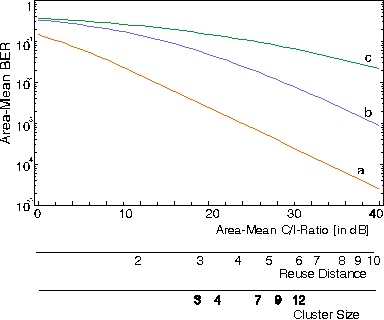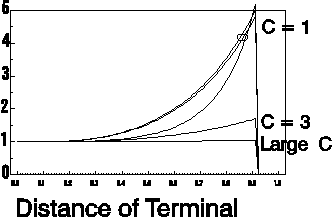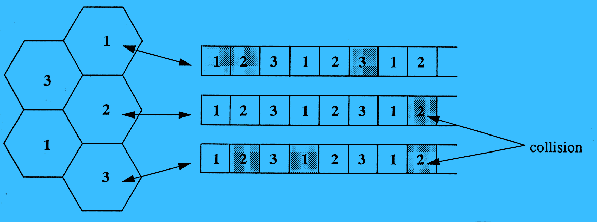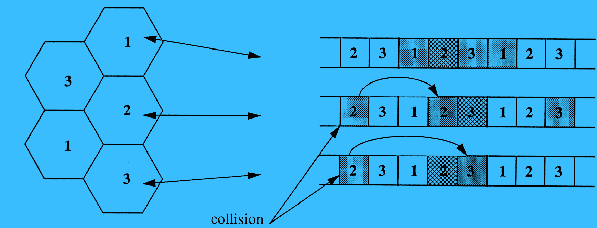
| Multiplexing in the downlink | ||
|
by Jean-Paul M.G.
Linnartz
|
||
|
In cellular telephony, regular frequency reuse is used. The performance criterion is the outage probability at the cell boundary. For Internet and other data trafic, this solution appears far less optimum that commonly thought. In particular, it needs optimization for a totally different criterion. |
||
In a cellular telephone system, radio channels are reused in as many cells as possible. A critical design factor is the number of different channels C that are required to ensure that cells using the same (set of) radio channel(s) are separated sufficiently in space. Text books often assume idealized hexagonal cells, typically with C = 7, 9. In such case the distance between the centers of two co-channel cells is R Ö(3 C), where R is the cell radius. For a mobile terminal located near the fringe of its cell, this leads to an outage probability Pout of

An extended model, also considering shadowing produces results as in Figure 1. The operator can trade speech quality (affected by signal outages) for spectrum efficiency and the number of subscribers that can be accepted. In practice operators use graph-coloring theory to find optimal frequency plans for practical cell shapes based on more realistic large-scale propagation models.

Figure 1: BER versus area-mean C/I. The average C/I values is also expressed in terms of the reuse distance and the cluster size C. Shadowing: 0, 6 and 12 dB (a,b,c resp.)
This mindset has been the starting point for 3G and 4G networks although the required QoS is quite different from that of speech. The performance of packet-switched networks can be studied from a different model in which each base station has a packet queue for messages to be sent to mobile terminals. Packets have a uniform length of L bits, arrive according to a Poisson process, and are destined for terminals uniformly distributed over the cell area. If a packet is received successfully the terminal sends an acknowledgment. If no acknowledgment is received, the base station repeats the packet until successful reception occurs.

Figure 2: Model of packet switched radio network
Without going through the details of the derivation, we now review some results from this scenario. All signals are assumed to experience Rayleigh fading and shadow attenuation, independent of each other and independent from one transmission attempt to the next. The path loss is assumed constant during all retransmission attempts. Interfering signals arrive from base stations in other cells. Since the probability of successful reception Q(r) decreases with increasing propagation distance r, the number of (re-) transmission attempts, M, statistically increases with increasing r. The service time S per packet is S = M TL with TL the duration of a time slot. The bit rate per Hz is denoted as hr, and the total system bandwidth is BN. So, TL = L / (hr Bw) = L C / (hr BN) where Bw denotes the bandwidth per cell with Bw = BN/C. The maximum effective throughput in user bits per second per base station per Hz, is
![]()
The probability of successful reception of a data packet depends also on the activity of interfering base stations. Typically the RF radio carrier is switched off if no packets are to be transmitted, so the probability that an interfering base station is active is equal to the probability that its queue is non-empty. In a spatially uniform system with uniform traffic, this probability is identical for all base stations. The number of packets waiting in the base station can be modelled as an M/G/1/¥ queue. Service times conditional on r are geometric with mean TL/Q(r) but the unconditional distribution of service times is not a closed-form expression. In [] the service time of successive packets is modelled as as i.i.d. random variables. The mean value of the service time, expressed in number of slots and averaged over all locations in the cell, is

The second moment is

The expected queuing delay is found from the Pollacek-Khintchine expression for M/G/1/¥ queues, namely

Figure 3 gives the expected number of required transmission attempts versus terminal location. That is, it depicts 1/Q(r), rather than 1 - Q(r) as one would study for outage probabilities relevant to circuit switching. We address a typical narrowband modulation technique with receiver threshold z = 4 (6 dB), and shadowing with a spread of 6 dB. Service times in seconds can be obtained by multiplying results in Figure 3 by L / (hr BN).

Figure 3: Expected number of (re-) transmissions versus location of the mobile terminal in the cell.
Figure 4 gives the queuing delay in the base station as a function of the message arrival rate m /hr per cell. It shows that C = 1 is optimum. The relatively high bandwidth in each cell allows the base stations to empty their queues fairly rapidly, which reduces Pon thus the interference to other cells.

Figure 4: packet arrival rate versus delay for various reuse cluster sizes.
According to these results, in high-capacity spectrum-efficient packet-switched networks, adjacent base stations preferably compete for non-disjoint (i.e., interfering) spectrum resources. The above computations showed that spectrum efficiency is optimal if the full system bandwidth can be used in all cells. Note that this is in contrast to common practice in today's radio networks and to the principles used for the narrowband networks of the future. However, continuing interference between transmissions from adjacent base station may severely affect the performance of such networks. Service times of successive packets may be correlated. For instance if one packet experiences heavy interference from transmissions by anther base station, it is more likely that the next packet will also see an active co-channel base station. Furthermore, two adjacent base stations may continue to attempt to transmit to terminals at unfavorable locations. To avoid such instability problems, the access protocol must resolve this..
This suggests that efficient, coordinated resolution of collisions between packet retransmissions in adjacent cells is necessary to guarantee efficient performance of wireless data and multi-media networks. This still is a largely unexplored research field. We now give an example of a scheme that can help mitigating the effect of continued collisions in packet-switched radio data networks with dense frequency reuse.
In this scheme, all base stations share the same transmit channel, which has frames of three time slots. The areas covered by each base station are assigned a sequence number {1, 2 or 3} according to a map-coloring scheme which ensures that adjacent areas always have a different number.

Figure 5:
In normal operation, a base station can transmit in any time slot regardless of its number. If base stations in adjacent areas happen to transmit simultaneously, most signals may nonetheless 'capture' their intended receiver. With some probability however, interference erases some messages involved in this `collision'.

Figure 6:
In the latter case, the base station will retransmit the lost message in the slot of the next frame with the corresponding number. During this retransmission, all adjacent base stations are silenced to prevent another collision (Figure 6). This coordination can be performed by protocols using the fixed backbone infrastructure, connecting all base stations.
next: study of the uplink